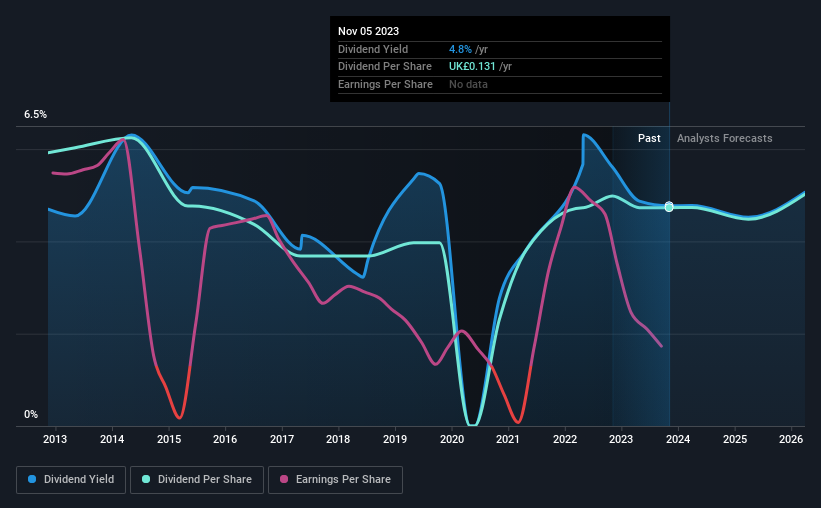- United Kingdom
- /
- Food and Staples Retail
- /
- LSE:SBRY
Don't Buy J Sainsbury plc (LON:SBRY) For Its Next Dividend Without Doing These Checks

It looks like J Sainsbury plc (LON:SBRY) is about to go ex-dividend in the next three days. The ex-dividend date occurs one day before the record date which is the day on which shareholders need to be on the company's books in order to receive a dividend. It is important to be aware of the ex-dividend date because any trade on the stock needs to have been settled on or before the record date. In other words, investors can purchase J Sainsbury's shares before the 9th of November in order to be eligible for the dividend, which will be paid on the 15th of December.
The company's next dividend payment will be UK£0.039 per share. Last year, in total, the company distributed UK£0.13 to shareholders. Looking at the last 12 months of distributions, J Sainsbury has a trailing yield of approximately 4.8% on its current stock price of £2.745. Dividends are an important source of income to many shareholders, but the health of the business is crucial to maintaining those dividends. That's why we should always check whether the dividend payments appear sustainable, and if the company is growing.
See our latest analysis for J Sainsbury
If a company pays out more in dividends than it earned, then the dividend might become unsustainable - hardly an ideal situation. Last year, J Sainsbury paid out 395% of its profit to shareholders in the form of dividends. This is not sustainable behaviour and requires a closer look on behalf of the purchaser. Yet cash flows are even more important than profits for assessing a dividend, so we need to see if the company generated enough cash to pay its distribution. It paid out 89% of its free cash flow as dividends, which is within usual limits but will limit the company's ability to lift the dividend if there's no growth.
It's disappointing to see that the dividend was not covered by profits, but cash is more important from a dividend sustainability perspective, and J Sainsbury fortunately did generate enough cash to fund its dividend. Still, if the company repeatedly paid a dividend greater than its profits, we'd be concerned. Very few companies are able to sustainably pay dividends larger than their reported earnings.
Click here to see the company's payout ratio, plus analyst estimates of its future dividends.

Have Earnings And Dividends Been Growing?
Businesses with shrinking earnings are tricky from a dividend perspective. If earnings fall far enough, the company could be forced to cut its dividend. J Sainsbury's earnings per share have fallen at approximately 24% a year over the previous five years. When earnings per share fall, the maximum amount of dividends that can be paid also falls.
Many investors will assess a company's dividend performance by evaluating how much the dividend payments have changed over time. J Sainsbury's dividend payments per share have declined at 2.2% per year on average over the past 10 years, which is uninspiring. While it's not great that earnings and dividends per share have fallen in recent years, we're encouraged by the fact that management has trimmed the dividend rather than risk over-committing the company in a risky attempt to maintain yields to shareholders.
Final Takeaway
Has J Sainsbury got what it takes to maintain its dividend payments? Earnings per share have been in decline, which is not encouraging. Additionally, J Sainsbury is paying out quite a high percentage of its earnings, and more than half its cash flow, so it's hard to evaluate whether the company is reinvesting enough in its business to improve its situation. With the way things are shaping up from a dividend perspective, we'd be inclined to steer clear of J Sainsbury.
With that in mind though, if the poor dividend characteristics of J Sainsbury don't faze you, it's worth being mindful of the risks involved with this business. Our analysis shows 3 warning signs for J Sainsbury and you should be aware of them before buying any shares.
If you're in the market for strong dividend payers, we recommend checking our selection of top dividend stocks.
If you're looking to trade J Sainsbury, open an account with the lowest-cost platform trusted by professionals, Interactive Brokers.
With clients in over 200 countries and territories, and access to 160 markets, IBKR lets you trade stocks, options, futures, forex, bonds and funds from a single integrated account.
Enjoy no hidden fees, no account minimums, and FX conversion rates as low as 0.03%, far better than what most brokers offer.
Sponsored ContentNew: Manage All Your Stock Portfolios in One Place
We've created the ultimate portfolio companion for stock investors, and it's free.
• Connect an unlimited number of Portfolios and see your total in one currency
• Be alerted to new Warning Signs or Risks via email or mobile
• Track the Fair Value of your stocks
Have feedback on this article? Concerned about the content? Get in touch with us directly. Alternatively, email editorial-team (at) simplywallst.com.
This article by Simply Wall St is general in nature. We provide commentary based on historical data and analyst forecasts only using an unbiased methodology and our articles are not intended to be financial advice. It does not constitute a recommendation to buy or sell any stock, and does not take account of your objectives, or your financial situation. We aim to bring you long-term focused analysis driven by fundamental data. Note that our analysis may not factor in the latest price-sensitive company announcements or qualitative material. Simply Wall St has no position in any stocks mentioned.
About LSE:SBRY
J Sainsbury
Engages in the food, general merchandise and clothing retailing, and financial services activities in the United Kingdom and the Republic of Ireland.
Solid track record with excellent balance sheet and pays a dividend.
Similar Companies
Market Insights
Community Narratives



